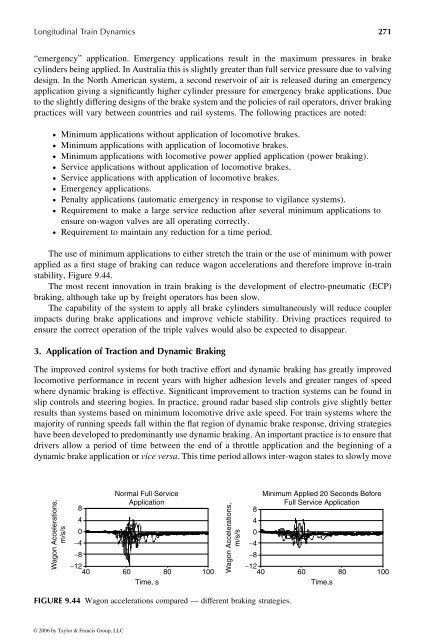Hi-Res PDF - CRCnetBASE
Hi-Res PDF - CRCnetBASE
Hi-Res PDF - CRCnetBASE
Create successful ePaper yourself
Turn your PDF publications into a flip-book with our unique Google optimized e-Paper software.
Longitudinal Train Dynamics 271<br />
“emergency” application. Emergency applications result in the maximum pressures in brake<br />
cylinders being applied. In Australia this is slightly greater than full service pressure due to valving<br />
design. In the North American system, asecond reservoir ofair is released during an emergency<br />
application giving asignificantly higher cylinder pressure for emergency brake applications. Due<br />
to the slightly differing designs of the brake system and the policies of rail operators, driver braking<br />
practices will vary between countries and rail systems. The following practices are noted:<br />
† Minimum applications without application of locomotive brakes.<br />
† Minimum applications with application of locomotive brakes.<br />
† Minimum applications with locomotive power applied application (power braking).<br />
† Service applications without application of locomotive brakes.<br />
† Service applications with application of locomotive brakes.<br />
† Emergency applications.<br />
† Penalty applications (automatic emergency in response to vigilance systems).<br />
† Requirement to make alarge service reduction after several minimum applications to<br />
ensure on-wagon valves are all operating correctly.<br />
† Requirement to maintain any reduction for atime period.<br />
The use of minimum applications to either stretch the train or the use of minimum with power<br />
applied as afirst stage of braking can reduce wagon accelerations and therefore improve in-train<br />
stability, Figure 9.44.<br />
The most recent innovation in train braking is the development of electro-pneumatic (ECP)<br />
braking, although take up by freight operators has been slow.<br />
The capability of the system to apply all brake cylinders simultaneously will reduce coupler<br />
impacts during brake applications and improve vehicle stability. Driving practices required to<br />
ensure the correct operation of the triple valves would also be expected to disappear.<br />
3. Application of Traction and Dynamic Braking<br />
The improved control systems for both tractive effort and dynamic braking has greatly improved<br />
locomotive performance inrecent years with higher adhesion levels and greater ranges ofspeed<br />
where dynamic braking is effective. Significant improvement totraction systems can be found in<br />
slip controls and steering bogies. In practice, ground radar based slip controls give slightly better<br />
results than systems based on minimum locomotive drive axle speed. For train systems where the<br />
majority of running speeds fall within the flat region of dynamic brake response, driving strategies<br />
have been developed to predominantly use dynamic braking.Animportant practice is to ensurethat<br />
drivers allow aperiod of time between the end of athrottle application and the beginning of a<br />
dynamic brake application or viceversa .Thistime period allowsinter-wagon states to slowlymove<br />
Wagon Accelerations,<br />
m/s/s<br />
8<br />
4<br />
0<br />
- 4<br />
- 8<br />
Normal Full Service<br />
Application<br />
- 12<br />
40 60 80 100<br />
Time, s<br />
Wagon Accelerations,<br />
m/s/s<br />
FIGURE 9.44 Wagon accelerations compared —different braking strategies.<br />
© 2006 by Taylor & Francis Group, LLC<br />
8<br />
4<br />
0<br />
- 4<br />
- 8<br />
Minimum Applied 20 Seconds Before<br />
Full Service Application<br />
- 12<br />
40 60 80 100<br />
Time,s









